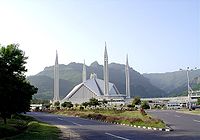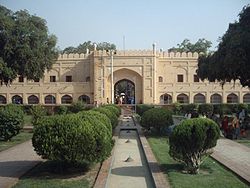Pakistani Studies/Culture
Demographics
[edit | edit source]
Pakistan has an estimated population of 165,803,560, as of April 2006. Pakistan has the world's sixth largest population,[1] placing it higher than Russia, and lower than Brazil. Because of Pakistan's high growth rate, it is expected to surpass Brazil in population in the year 2020. Population projections for Pakistan are relatively difficult because of the apparent differences in the accuracy of each census and the inconsistencies between various surveys related to fertility rate, but it is likely that the rate of growth peaked in 1980s.[2] The population was estimated at 162,400,000[3] on July 1, 2005, with a fertility rate of 34 per thousand, a death rate of 10 per thousand, and the rate of natural increase at 2.4%. Pakistan also has a high infant mortality rate of 70 per thousand births.[1]
Urdu is the national language of Pakistan, and English is the official language used in the Constitution and widely used by corporate businesses, the educated urban elite, and most universities. Punjabi is spoken by over 60 million people, but has no official recognition in the country. Pakistanis represent a variety of races and ethnic groups, mostly of Indo-European stock and hence quite distinct from the aboriginal peoples who inhabit this part of the Indian Sub-Continent. The large majority of Pakistanis belong to the Indo-Aryan ethnic group although there are a substantial number of Iranic peoples and smaller numbers of Dravidians. These major ethnic groups are further broken down into several smaller ethnic groups - Punjabis (44.68)% of the population, Pashtuns (15.42%), Sindhis (14.1%), Seraikis (10.53%), Muhajirs (7.57%), Balochis (3.57%) and others (4.66%) such as Tajiks, Bengalist and many others.
The demographics of religion in Pakistan were significantly influenced in 1947 by the movement of Muslims to Pakistan, and Hindus and Sikhs to India.[4] Census data indicates that 96% of the population are Muslims, of whom nearly 80% are Sunni Muslims and 19% are Shi'a Muslims. Pakistan has the second highest Shia population in the world, after Iran.[5] The remainder comprises Christians, Hindus, Jews, Sikhs, Parsis, Ahmadis, and Animists (mainly the Kalasha of Chitral). A few Buddhists are included in Pakistani statistics; however, these live in Indian administered Ladakh which Pakistan claims along with the rest of Kashmir. As of 2005, over three million refugees (approximately 81.5% being ethnic Pashtuns remain in Pakistan as a result of the wars in Afghanistan, with 83% of these refugees reporting their intent to permanently settle in Pakistan.[6]
Society and culture
[edit | edit source]

Pakistan has a rich and unique culture that has preserved established traditions throughout history. Many cultural practices, foods, monuments, and shrines were inherited from the rule of Muslim Mughal and Afghan emperors including the national dress of Shalwar Qameez. Women wear brightly coloured shalwar qameez, while men often wear solid-coloured ones, usually with a sherwani or achkan (long coat) that is worn over the garment.
The variety of Pakistani music ranges from diverse provincial folk music and traditional styles such as Qawwali and Ghazal Gayaki to modern forms fusing traditional and western music, such as the synchronisation of Qawwali and western music by the renowned Nusrat Fateh Ali Khan. Other major Ghazal singers include Mehdi Hassan, Ghulam Ali, Farida Khanum, Tahira Syed, Abida Parveen and Iqbal Bano. The arrival of Afghan refugees in the western provinces has rekindled Pashto and Persian music and established Peshawar as a hub for Afghan musicians and a distribution centre for Afghan music abroad. Until the 1990s, the state-owned Pakistan Television Corporation (PTV) and Pakistan Broadcasting Corporation were the dominant media outlets, but there are now numerous private television channels such as Geo TV, Indus TV, Hum, ARY, KTN, Sindh TV and Kashish. Various American, European, and Asian television channels and movies are available to the majority of the Pakistani population via cable and satellite television. There are also small indigenous movie industries based in Lahore and Peshawar (often referred to as Lollywood and Pollywood). Although Bollywood movies are banned, Indian film stars are generally popular in Pakistan.
Pakistani society is largely multilingual and predominantly Muslim, with high regard for traditional family values, although urban families have grown into a nuclear family system due to the socio-economic constraints imposed by the traditional joint family system.[7] Recent decades have seen the emergence of a middle class in cities like Karachi, Lahore, Rawalpindi, Hyderabad, Faisalabad, Sukkur and Peshawar that wish to move in a more liberal direction, as opposed to the northwestern regions bordering Afghanistan that remain highly conservative and dominated by centuries-old regional tribal customs. Increasing globalization has increased the influence of "Western culture" with Pakistan ranking 46th on the Kearney/FP Globalization Index.[8] There are an approximated four million Pakistanis living abroad, with close to a half-million expatriates living in the United States and around a million living in Saudi Arabia. Aswell as nearly one million people of Pakistani descent in the United Kingdom, there are burgeoning cultural connections.[9]
Tourism is a growing industry in Pakistan, based on its diverse cultures, peoples and landscapes. Ancient civilization ruins such as Mohenjo-daro, Harappa and Taxila, to the Himalayan hill stations attract those interested in field and winter sports. Pakistan is home to several mountain peaks over 7000m, which attracts adventurers and mountaineers from around the world, especially K2. The northern parts of Pakistan have many old fortresses, towers and other architecture as well as the Hunza and Chitral valleys, the latter being home to the small pre-Islamic Animist Kalasha community who claim descent from the army of Alexander the Great. Punjab is the site of Alexander's battle on the Jhelum River and the historic city Lahore, Pakistan's cultural capital with many examples of Mughal architecture such as the Badshahi Masjid, Shalimar Gardens, Tomb of Jahangir and the Lahore Fort.
Pakistani fashion is mainly based around different adaptations of the national dress of the country; the inimitable salwar kameez. The salwar kameez is a 3 piece suit that is worn across the country. Consisting of a pair of baggy trousers called the salwar, a long knee-length tunic called the kameez, and a loose veil called the dupatta, this traditional dress has been transformed into a stylish representation of the creativity of Pakistani fashion designers.
Holidays
[edit | edit source]
There are many holidays and festivals celebrated annually in Pakistan. While Pakistan is an Islamic nation, there are also several secular holidays including Pakistan Day (23 March), Independence Day (14 August), Defence of Pakistan Day (6 September), Pakistan Air Force Day (7 September), the anniversaries of the birth (25 December) and death (11 September) of Muhammad Ali Jinnah (Quaid-e-Azam), Allama Iqbal (9 November) and the birth (30 July) and death (8 July) of Madar-e-Millat. Labour Day (also known as May Day) is also observed in Pakistan on 1 May.
Several important festivals are celebrated by Pakistani Muslims during the year, dependent on the Islamic calendar. Ramadan, the ninth month of the calendar, is characterised by daytime fasting for 29 or 30 days and is followed by the festival of Eid ul-Fitr. In a second festival, Eid ul-Adha, an animal is sacrificed in remembrance of the actions of Abraham and the meat is shared with friends, family, and the less fortunate. Both Eid festivals are public holidays, serving as opportunities for people to visit family and friends, and for children to receive new clothes, presents, and sweets. Some Muslims celebrate [Eid-e-Milad-un-Nabi, the birthday of the prophet Muhammad, in the third month of the calendar (Rabi' al-Awwal). Shia Muslims mark the Day of Ashurah on the 9th and 10th days of the first month (Muharram) to commemorate the martyrdom of Husayn bin Ali, (the grandson of prophet Muhammad).
Hindus, Buddhists, Sikhs, and Christians in Pakistan also celebrate their own festivals and holidays. Sikhs come from across the world to visit several holy sites in Punjab, including the shrine of Guru Nanak, the founder of Sikhism, at Hassan Abdal in the Attock District, and his birthplace, at Nankana Sahib. There are also several regional and local festivals, such as the Punjabi festival of Basant, which marks the start of spring and is celebrated by kite flying.
Sports
[edit | edit source]The official and national sport of Pakistan is field hockey, although squash and cricket are also very popular. The Pakistani cricket team has won the Cricket World Cup once (in 1992), were runners-up once (in 1999) and co-hosted the games twice (in 1987 and 1996). The team has also won the Australasia Cup thrice (1986, 1990, 1994). Pakistan has been always in the forefront when it comes to the game of squash. Jahangir Khan and Jansher Khan are some of the well known stars of the game.
Muhammad Yousuf was remained world champion in game of snooker in 90s. At an international level, Pakistan has competed many times at the Summer Olympics in field hockey, boxing, athletics, swimming, and shooting. Pakistan's medal tally remains at 10 medals (3 gold, 3 silver and 4 bronze) while at the Commonwealth games and Asian Games it stands at 61 medals and 182 medals respectively. Hockey is the sport that Pakistan has been most successful at the Olympics, with three gold medals (1960, 1968, 1984). Pakistan has also won the Hockey World Cup a record four times (1971, 1978, 1982, 1994). Pakistan has hosted several international competitions, including the SAF Games in 1989 and 2004.
A1 Grand Prix racing is also becoming popular with the entry of a Pakistani team in the 2005 season. The Tour de Pakistan, modeled on the Tour de France, is an annual cycling competition that covers the length and breadth of Pakistan. Recently, football has grown in popularity across the country, where traditionally it had been played almost exclusively in the western province of Balochistan.
References
[edit | edit source]- ↑ a b International Data Base U.S. Census Bureau. URL accessed on 5 May 2006. Invalid
<ref>tag; name "US Census Bureau" defined multiple times with different content - ↑ Feeney and Alam, 2003
- ↑ Population Reference Bureau's 2005 World Data Sheet
- ↑ Census results for languages of Pakistan
- ↑ Census results for shia population in Pakistan
- ↑ UNHCR Statistical Summary Report: Census of Afghans in Pakistan
- ↑ Beinart, Peter. "Understate". The New Republic Online. July 01, 2002.
- ↑ Kearney Foreign Policy Globalization Index
- ↑ Howells, Kim. Kim Howells arrives in Pakistan. Foreign and Commonwealth Office (National). September 6, 2006. URL accessed October 22, 2006
